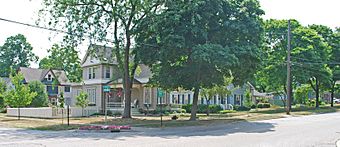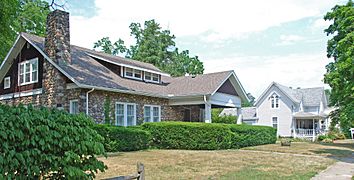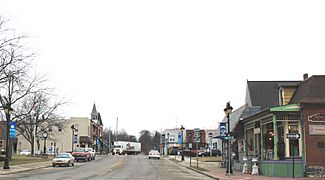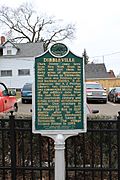Dibbleville-Fentonville Historic District facts for kids
Quick facts for kids |
|
|
Dibbleville-Fentonville Historic District
|
|

Corner of Leroy and Rockwell Streets, looking south
|
|
| Location | Roughly bounded by Shiawassee, Riggs, Holly and George Sts., Fenton, Michigan |
|---|---|
| Area | 49 acres (20 ha) |
| Architectural style | Mid 19th Century Revival, Late 19th And 20th Century Revivals |
| MPS | Genesee County MRA |
| NRHP reference No. | 82000507 |
| Added to NRHP | November 26, 1982 |
The Dibbleville-Fentonville Historic District is a special area in Fenton, Michigan. It's filled with old houses and buildings that show what the town was like long ago. This district is important because it helps us remember the history of Fenton. It was added to the National Register of Historic Places in 1982.
Contents
How Fenton Began
A man named Clark Dibble came to Michigan from New York in the 1830s. He found a great spot where many Native American trails met. He thought this place would be perfect for a new town because it was easy to get to. So, in 1834, he started a settlement called Dibbleville. He even built a sawmill there.
New Owners and a New Name
Clark Dibble didn't stay long. In 1836, two men named Robert LeRoy and William M. Fenton bought the whole town. Robert's father, Judge Daniel LeRoy, believed a railroad would come through the area. He thought this would make the town very successful.
In 1837, LeRoy and Fenton planned out the town. They renamed it Fentonville. More settlers arrived, opening stores, mills, and hotels. The town grew quickly. The main part of Fentonville was around where Shiawassee and Leroy Streets met. Early settlers built their homes close to this busy area.
The Railroad Arrives
A big change happened in 1856. The Detroit and Milwaukee Railroad built a train line right through Fentonville. This made the town grow even more! New businesses opened, like a fruit canning factory, a wool factory, and a brewery.
Both homes and businesses expanded in the town. Fentonville became a major place for buying, selling, and shipping goods. It stayed important until the early 1900s. Then, nearby Flint became the bigger city.
Fenton Today
As cars became more popular, Fenton's role as a market and factory town changed. However, many people found jobs in the car factories in Flint, Pontiac, or Lansing. They could live in Fenton and drive to work. Today, Fenton is still a "bedroom community." This means many people live there but work in bigger cities nearby.
What You'll See in the District
The Dibbleville-Fentonville Historic District has 130 buildings. Most of these, 119, are very old and add to the historic feel of the neighborhood. Many of the buildings, 111 of them, were originally homes. Some of these old houses are now used as businesses. There are also 12 commercial buildings, four churches, and three public buildings.
Architectural Styles
The buildings show many different styles of architecture from the past. You can see homes built between the 1830s and 1860s in styles like Greek Revival and Gothic Revival. Later, in the 1800s, buildings were made in the Italianate and Queen Anne styles.
Around the year 1900, new styles appeared. These include Shingle, Colonial Revival, Mission, Spanish Revival, and Bungalow styles. The houses vary in size, from large mansions to smaller homes where workers lived. They are built from wood, brick, cement blocks, stone, or a mix of these materials.
The Heart of the District
The main part of the district is a T-shaped area where Leroy and Shiawassee Streets meet. This area has two blocks of commercial buildings. Most of these are two-story brick buildings in the Italianate style. Many have fancy metal fronts, arched windows, and decorative tops. Four churches are also located nearby. The commercial area is surrounded by many historic homes.
Gallery




